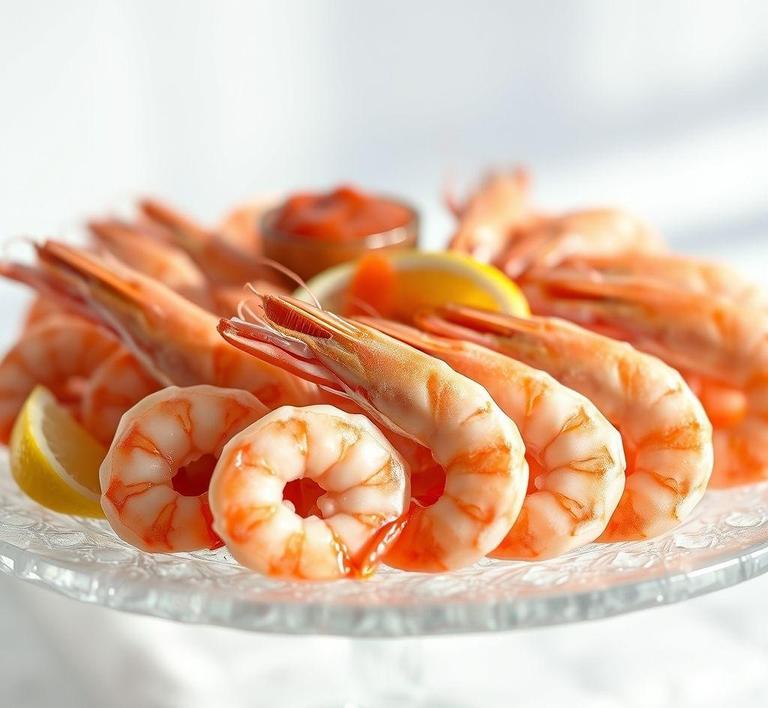If you’ve ever found yourself with a half-eaten bag of cocktail shrimp and wondered whether it’s safe to refreeze them, you’re not alone! Whether you bought too much or just didn’t get around to finishing it, understanding the best practices for refreezing cocktail shrimp is key to keeping them fresh and delicious for the next time you want to serve them. In this guide, we’ll walk you through the steps to safely refreeze cocktail shrimp, the potential risks to consider, and some handy tips to make sure your shrimp stay tasty and ready to impress your guests!
Can You Refreeze Cocktail Shrimp?

The question of whether you can refreeze cocktail shrimp is one that many seafood lovers and home cooks have pondered, especially when faced with leftover shrimp from a party, gathering, or an accidental over-purchase. The short answer is yes, it is technically possible to refreeze cocktail shrimp, but there are some important factors to consider before doing so.
Seafood, like shrimp, is highly perishable and has a delicate texture, making it especially sensitive to temperature fluctuations. When shrimp is frozen, thawed, and then refrozen, it goes through a cycle of freezing and thawing that can cause its quality to deteriorate. This is largely due to the breakdown of cell walls during the thawing process, which releases moisture, resulting in a mushier texture when refrozen and later reheated.
The key issue with refreezing shrimp, or any seafood, lies in how it was handled between the first and second freezing process. If the shrimp was thawed improperly (e.g., left at room temperature too long or thawed and refrozen multiple times), it may pose food safety risks such as bacterial growth. However, if it was thawed properly and handled with care, then refreezing can be done with relative success, though the quality may not be as good as the first freeze.
How To Refreeze Cocktail Shrimp?
If you’ve decided to go ahead and refreeze your cocktail shrimp, it’s crucial to do so in a way that minimizes the potential damage to their quality and maintains food safety. Here’s a step-by-step guide to help you do this correctly:
-
Ensure Proper Thawing
When you first thaw your shrimp, make sure it’s done correctly. The best way to thaw shrimp is in the refrigerator over several hours or overnight. This keeps them at a safe temperature, minimizing the risk of bacterial growth. Never thaw shrimp at room temperature, as it encourages bacteria to proliferate.
-
Inspect The Shrimp
Before refreezing, ensure that the shrimp hasn’t been left out at room temperature for extended periods. If the shrimp was improperly thawed or left out too long, it’s better to discard it for health safety. Always inspect for any signs of spoilage such as off smells or sliminess.
-
Pat Dry
Once the shrimp has thawed, gently pat it dry with paper towels. Excess moisture can lead to freezer burn and deteriorate the texture of the shrimp. Drying them off also helps maintain the best possible texture when they’re reheated later.
-
Use An Airtight Container Or Freezer Bags
After patting the shrimp dry, place them in a freezer-safe bag or airtight container. For added protection, remove as much air as possible from the bag to reduce the risk of freezer burn. Vacuum-sealing is ideal if you have a vacuum sealer at home.
-
Label And Date
Make sure to label the container or bag with the date of refreezing. This allows you to keep track of how long the shrimp has been in the freezer. As a general rule, refrozen shrimp should be consumed within one to two months for the best taste and texture.
-
Freeze Quickly
Place the shrimp in the coldest part of the freezer and let it freeze quickly. The faster it freezes, the less likely it is that large ice crystals will form, which can rupture the shrimp’s delicate tissue.
Quality Impact
While it is possible to refreeze cocktail shrimp, it’s important to understand the potential impact on quality. The primary concern when refreezing shrimp is the texture. Shrimp has a naturally delicate texture, and freezing, thawing, and refreezing multiple times can result in a loss of that desirable firmness.
When shrimp is frozen, the water inside its cells turns into ice crystals. These crystals can rupture cell walls, and when the shrimp is thawed, it can release moisture. This moisture loss is a primary cause of the shrinkage and the softer, sometimes mushy texture that can result when the shrimp is refrozen. With each thaw-and-refreeze cycle, the quality of the shrimp diminishes further.
Additionally, the flavor of the shrimp may also be compromised, especially if the shrimp wasn’t initially frozen in an airtight environment or if it was exposed to air for too long before being refrozen. The development of freezer burn-caused by exposure to air-can result in off-flavors and an overall decrease in taste.
However, if done properly and under optimal conditions, the quality degradation can be minimized. Shrimp that was frozen fresh and thawed properly will generally fare better than shrimp that was already cooked or pre-processed before freezing. If the shrimp was cooked before freezing (as is often the case with cocktail shrimp), the flavor and texture might not change dramatically when refrozen, but the overall experience might still be less pleasant compared to freshly frozen shrimp.
Refreezing cocktail shrimp is not without its challenges, especially when it comes to maintaining its quality and texture. While it’s technically possible to refreeze shrimp safely, it’s essential to follow proper thawing, handling, and freezing practices to minimize any potential food safety issues and preserve as much of the shrimp’s original flavor and texture as possible.
If you plan to refreeze cocktail shrimp, ensure that they’ve been handled carefully throughout the entire process, from initial freezing to thawing and finally refreezing. Always check for signs of spoilage before refreezing, and remember that the longer shrimp stays in the freezer, the greater the chance of quality degradation. Ideally, refreezing should be a last resort. If you don’t think you’ll be able to eat the shrimp within a reasonable time frame, consider adjusting your portion sizes or finding creative ways to use the shrimp in your meals to avoid the need to refreeze.
Ultimately, while refrozen shrimp may not offer the same eating experience as fresh or properly frozen shrimp, it remains a viable option for those looking to preserve leftovers without wasting food. Just proceed with caution and always keep food safety in mind.
Is It Safe To Refreeze Cocktail Shrimp?
When it comes to refreezing cocktail shrimp, safety largely hinges on how they were handled during the first freezing and thawing process. The key factor to consider is the safety of the shrimp in terms of bacterial growth and maintaining the best quality. If the shrimp were thawed properly in the fridge (not at room temperature), then it can be refrozen, but it’s essential to note that the refreezing process could impact the texture and flavor.
Here’s the breakdown:
- Thawing Method: The shrimp should always be thawed in the refrigerator rather than on the counter. Thawing them at room temperature for more than 2 hours can cause harmful bacteria like Salmonella and Vibrio to multiply, and even though refreezing them may slow down the bacteria’s growth, it won’t kill them.
- Quality Loss: Refreezing shrimp can lead to a significant loss in quality. Shrimp have a high water content, and when frozen, ice crystals form inside their tissues. Upon thawing, these crystals break down the cells, resulting in a mushy texture. Refreezing only exacerbates this process, making the shrimp less appealing and harder to enjoy.
- The Rule of Thumb: If the shrimp were thawed in the refrigerator and not exposed to temperatures higher than 40°F (4°C) for extended periods, they can technically be refrozen. However, it’s recommended to consume them as soon as possible for the best taste and texture.
Signs That Cocktail Shrimp Should Not Be Refrozen
There are several red flags to look out for that indicate shrimp shouldn’t be refrozen. These signs often point to improper handling or spoilage, which makes refreezing dangerous, or at the very least, undesirable.
- Off Smell: Fresh shrimp should have a clean, slightly briny odor. If the shrimp has a sour or ammonia-like smell, it’s a sign that they’ve started to spoil. Refreezing shrimp in this state will not only result in a terrible taste but could also pose health risks. Always trust your nose-if the shrimp smells off, throw it away.
- Slimy or Sticky Texture: Shrimp should have a firm, smooth texture. If they feel slimy or sticky to the touch, this indicates bacterial growth. Refreezing shrimp that have this texture will make the issue worse and can lead to foodborne illnesses.
- Discoloration: If the shrimp has developed any brown spots or unusual discoloration, it could indicate freezer burn or that they’ve been in the fridge for too long. Discoloration can also be a sign that the shrimp is beginning to deteriorate, which means it’s better not to refreeze them.
- Thawed for Too Long: If shrimp have been left out at room temperature for more than two hours or have been thawed improperly (like in warm water or on the countertop), it’s best to discard them. Refreezing at this point may just lock in harmful bacteria that can lead to food poisoning when consumed later.
Common Refreezing Mistakes
When it comes to refreezing shrimp, there are a few common mistakes that can jeopardize both safety and quality:
- Thawing at Room Temperature: One of the biggest mistakes is thawing shrimp too quickly by leaving them on the counter at room temperature. This can cause them to reach unsafe temperatures (above 40°F or 4°C), leading to bacterial growth. It’s essential to thaw shrimp in the fridge or under cold running water to maintain safety.
- Refreezing Multiple Times: Refreezing shrimp over and over again is a surefire way to degrade the texture and flavor. Every time the shrimp is thawed and refrozen, it loses moisture, resulting in a rubbery, tough, or mushy texture. Stick to a one-time freeze and thaw cycle to avoid this problem.
- Not Using Airtight Packaging: If you refreeze shrimp without properly sealing them in airtight packaging, you risk freezer burn. The moisture inside the shrimp will evaporate, leaving the shrimp dry and tasteless. Freezer burn can be avoided by using high-quality, vacuum-sealed bags or tightly wrapped plastic wrap.
- Thawing Too Much at Once: If you’re planning to refreeze shrimp, make sure to only thaw what you need. Once you thaw more than you can eat, the remaining shrimp will have to be refrozen, but they may not hold up well after that second freeze. Thaw in portions that you’ll use within 24 hours to reduce waste and maintain quality.
Tips And Tricks
- Thaw Safely: The best way to thaw shrimp is overnight in the refrigerator. This will ensure the shrimp stays at a safe temperature, preventing bacterial growth. If you’re in a rush, placing shrimp in a sealed bag and running cold water over them can thaw them relatively quickly without introducing warmth into the equation.
- Use a Vacuum Sealer: If you’re going to refreeze shrimp, invest in a vacuum sealer. It’s a great way to keep shrimp from drying out or getting freezer burn. By removing air from the packaging, you prevent ice crystals from forming and protect the texture of the shrimp.
- Separate Into Portions: If you only plan on eating a portion of your cocktail shrimp at a time, separate them into smaller portions before freezing. This way, you can defrost only what you need without refreezing the entire batch.
- Cook Before Refreezing: If you’re unsure whether you’ll be able to use the shrimp soon, cooking them before refreezing can help preserve their quality. Once cooked, shrimp can be safely frozen and then reheated without significant loss of texture.
- Use Shrimp Quickly: For the best quality, try to use thawed shrimp within 24 hours of taking them out of the freezer. Even if you decide not to refreeze them, it’s important to eat them while they’re fresh to avoid the risk of spoilage.
Conclusion
Refreezing cocktail shrimp is not ideal but can be done safely under the right conditions. If shrimp were thawed correctly in the fridge, they can be refrozen, but expect a decline in texture and quality with each cycle. The most critical factor in refreezing shrimp is maintaining proper food safety practices-ensuring they haven’t been left out at room temperature for too long and that they haven’t begun to spoil. Watch out for signs like an off smell, slimy texture, or discoloration, as these indicate that the shrimp should not be refrozen.
For the best taste and safety, avoid excessive thawing and refreezing cycles. Use proper storage techniques, and always aim to thaw only what you need. If you follow these tips, you can safely enjoy shrimp on more than one occasion, without compromising too much on the quality!

